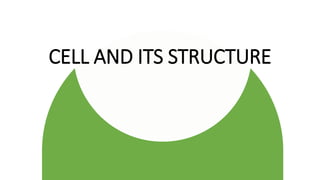
CELL AND ITS STRUCTURE for high school.pptx
- 1. CELL AND ITS STRUCTURE
- 2. Chapter Outlines: i) What is a cell and how is it seen ii) Eukaryotic cells have internal membranes that compartmentalize their functions iii) The eukaryotic cell’s genetic instructions are housed in the nucleus and carried out by the ribosomes iv) The endomembrane system regulates protein traffic and performs metabolic functions v) Mitochondria and chloroplasts change energy from one form to another vi) The cytoskeleton is a network of fibers that organizes structures and activities in the cell vii) Extracellular components and connections between cells help coordinate cellular activities 2
- 3. Presentation title 3 So at first what is A CELL? Cell is a structural and functional unit of life. So What types of cell Are there: Eukaryotic cell These are cells with a true nucleus, and contain many membrane-bound organelles. These include the animal cells, human cells, plant cells and even fungi. • Prokaryotic cells Cells that do not contain any true nucleus and also no other membrane bound organelles. Now generally, eukaryotes cells have a typical size of 10- 20µm. While prokaryotes cells have a typical size of 0.1 to 5.0µm. Meaning eukaryotes are generally bigger than prokaryotes.
- 4. Presentation title 4 Other terms you need to know: • Organnelles: They are functionally and structurally distinct part of a cell. And are surrounded by membranes for compartmentalization. • Ultrastructure of Cells Not necessarily surrounded by membranes surrounded by membranes detailed structures of a cell Only can be seen under an electron microscopes • Types of Microscopes: • Light microscope • Electron Microscope
- 6. Presentation title 6 Cell membrane:
- 7. Presentation title 7 Nucleus General Function: • Contains genetic information for the synthesis of protein • Also the site of transcription of genes and production of mRNA. Has three components: • Nuclear envelope • Nucleolus • Chromatin • Nucleoplasm
- 9. Presentation title 9 Ribosomes: • Is the Smallest Organelle • It is not bound by a membrane • Is made up of rRNA, that is synthesized in nucleolus + some protein • It has two subunits Large subunit and small subunit. Function Is the site of protein synthesis There are two types of ribosomes: 70S Are smaller in size and can be found in mitochondria and chloroplasts of eukaryotes 80S Are larger and can be found in cytoplasm and RER of all eukaryotes
- 10. Presentation title 10 Rough Endoplasmic Reticulum
- 11. Presentation title 11 Smooth Endoplasmic Reticulum It is an ER without ribosomes. Function Is the site of lipid and steroid synthesis Golgi Apparatus • Is made up of cisternae • Have layered appearance • No connection between members • Not continuous with nuclear envelope • Swellings at end of sacs for vesicle formation • Constantly being formed and broken down • Being formed by: Transport vesicles from RER on the cis face • Broken down to form: Secretory vesicle and lysosomes on transface
- 13. Presentation title 13 Mitochondria Function • Is the site of aerobic respiration And synthesizes ATP/produces energy in the form of ATP
- 15. Presentation title 15 Cell Wall • Is a thick, rigid layer which is made up of cellulose • It is permeable as there are spaces/gaps between fibres. Plasmodesmata • Is strands of cytoplasm passing through channels
- 17. Presentation title 17 Centrioles and Centrosomes Functions • Is involved in cell division Replicates before each cell division and moves to opposite poles. Centrioles are found in pairs at right angles from each other These two form centrosome • Modified centrioles are also found elsewhere • Acts as a Microtubule Organizing Center(MTOC)
- 18. Presentation title 18 Microtubules Function • Makes up the cytoskeleton (together with actin filaments) This in therefore provides the mechanical support Also it acts as an intracellular transport system for movement of vesicles or other components
- 19. THANK YOU